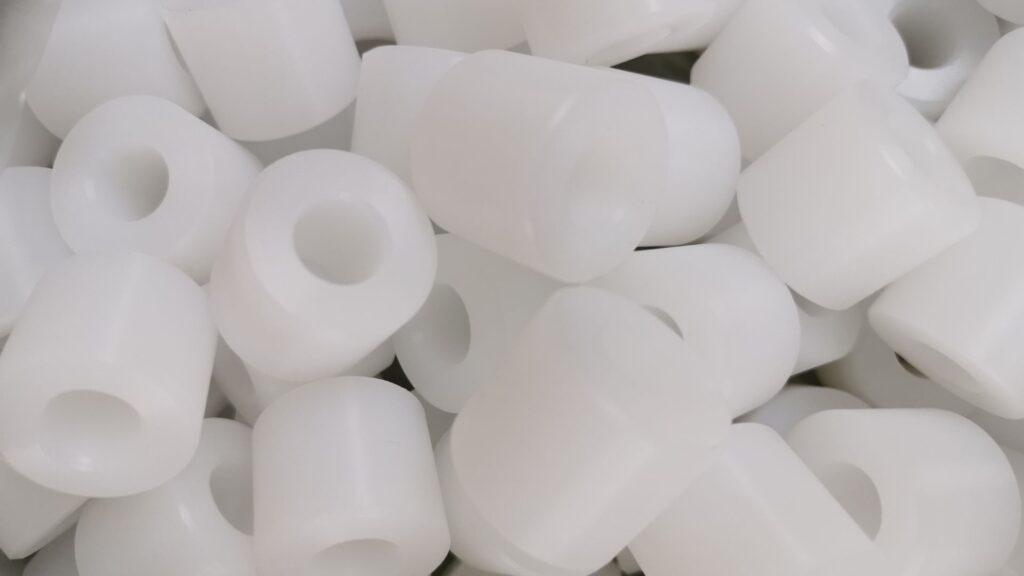
PTFE and aerospace industrial, automotive, and medical applications
High industrial standards and the constant evolution of production processes necessitate a careful selection of materials.
Elements such as rods, sheets, gaskets, self-adhesive tapes and thin wall pipes – especially those made from advanced engineering plastics like PTFE—are indispensable in safe and efficient projects.
The distinctive versatility of PTFE, combined with advanced technical properties, allows for wide application in various fields, including automation, electronics, construction, and mechanics, contributing to improved production performance and reduced intervention times.
Among the most valued materials is PTFE, a high-performance fluoropolymer with exceptional durability and technical properties.
It consistently delivers top performance—even in the most challenging industrial environments.
In this blog, we’ll take a closer look at PTFE’s key properties, its role in high-tech industries, the advantages that make it a top choice for engineers and manufacturers, and the challenges to keep in mind when working with it.
The essential properties of PTFE for high-performance engineering
Polytetrafluoroethylene (PTFE) is a polymer derived from monomers called tetrafluoroethylene. It’s known for its incredible chemical resistance, low coefficient of friction, and high-temperature resistance.
It withstands extreme temperatures and harsh chemicals, exhibiting a remarkably low friction coefficient.
These properties make it ideal for diverse PTFE industrial applications, including gaskets, coatings, PTFE self-adhesive tape, and high-performance components.
Here’s an overview of the PTFE properties that make it essential for a wide range of semi-finished plastic products used in demanding environments.
- Chemical resistance: it is inert and non-reactive to most chemical agents—including organic solvents, bases, acids, and oxidizing substances. This property makes it ideal for use in corrosive environments, such as chemical processing plants.
- Thermal stability: PTFE has low thermal conductivity, making it an excellent thermal insulator. It’s non-flammable and remains stable for extended periods at temperatures up to 260 °C (500 °F).
- Low friction coefficient of PTFE: the extremely low coefficient of friction enhances mechanical movement efficiency, making it self-lubricating. It’s ideal for applications that require smooth sliding and minimal energy loss.
PTFE in high-tech industries
PTFE has become one of the most widely used materials in a broad range of high-performance industrial applications.
It becomes essential in settings where precision, durability, and reliability are key. In sectors such as automation, aerospace, chemical processing, medical technology, and advanced electronics, PTFE in engineering stands out for its versatility.
It is used to manufacture different components such as PTFE Rods, PTFE Sheets, PTFE Thin Wall Pipes, PTFE Self-Adhesive Tape, and PTFE Expanded Sheets—all considered essential semifinished plastic materials for complex applications, such as:
- Chemical processing: PTFE’s exceptional chemical resistance makes it ideal for industrial applications involving exposure to aggressive substances or corrosive environments. It is suited to produce gaskets, seals, linings, and piping in chemical processing plants. The material’s natural inertness ensures long-lasting and reliable performance over time.
- Aerospace and automotive: in the automotive and aerospace fields, PTFE is widely used for its inherent ability to perform under extreme conditions. Its high thermal stability, low coefficient of friction, and excellent wear resistance make it ideal for components such as bushings, bearings, seals, and cable insulation. PTFE rods and PTFE sheets are frequently used in lightweight, high-performance parts that meet the most rigorous technical and regulatory standards.
- Medical and pharmaceutical: PTFE’s biocompatibility, chemical resistance, and non-toxicity make it a highly suitable material for use in the medical and pharmaceutical industries. Tubing, membranes, filters, and coatings for surgical instruments are just some of its common applications. Products such as PTFE thin wall pipes and PTFE expanded sheets are especially well-suited for environments where sterility, resistance to cleaning agents, and long-term material integrity are essential.
PTFE in industrial design: a trusted choice for professionals
Engineers, designers, and production managers have long favored PTFE for its unique combination of technical properties that make it exceptionally reliable.
Its versatility allows PTFE to be easily shaped into forms like thin wall pipes, gaskets, tapes, rods, and sheets, meeting a wide range of manufacturing needs.
Its durability and low maintenance requirements not only improve system efficiency but also lead to a significant reduction in operating costs.
Advantages of using PTFE
Compared to other engineering plastics, PTFE is non-flammable, offers one of the lowest friction coefficients, remains stable at high temperatures, and provides excellent chemical resistance.
These key PTFE properties make it a go-to material for professionals working with industrial plastics or seeking high-performance solutions in technical, mechanical, and scientific fields.
Among the most appreciated benefits of PTFE are its long lifespan, ease of fabrication into various forms, and availability as semi-finished plastic materials that meet a wide range of design requirements.
It’s no surprise that Teflon sheets and other fluoropolymer thermoplastics are now indispensable in cutting-edge PTFE industrial applications.
Challenges and considerations
PTFE offers numerous advantages and plays a vital role in several industrial applications.
However, like any advanced material, it also comes with challenges that should be considered carefully. In particular, cost and processing requirements can become significant factors—especially in large-scale or high-precision manufacturing. Let’s take a closer look.
PTFE Cost factors
As a high-performance material, PTFE generally comes at a higher cost than standard engineering plastics.
This cost factor can influence overall budgets, particularly in large-scale production scenarios.
However, its cost-benefit ratio should not be overlooked: long service life, minimal maintenance, and outstanding reliability often make the initial investment well worth it.
Processing limitations of PTFE
While versatile and efficient, PTFE does pose processing challenges.
Its low surface energy, for instance, complicates bonding and adhesion, often necessitating additional treatments like etching or alternative joining methods such as heat sealing or sintering.
The material’s unique mechanical and thermal properties also demand specialized machinery and precise processing parameters. Furthermore, compared to other
engineering plastics, PTFE can generate waste, making meticulous production planning crucial.
Despite these challenges, PTFE remains a strategic choice for those seeking reliability, durability, and consistent performance over time.
A careful evaluation of application requirements allows you to leverage the potential of this high-performance material.
Looking for high-performance PTFE components?
Discover our full range of PTFE products such as rods, sheets, tapes, gaskets, and custom-made parts—engineered for precision, durability, and industrial reliability.
Explore our solutions at ptfe-felis.com


